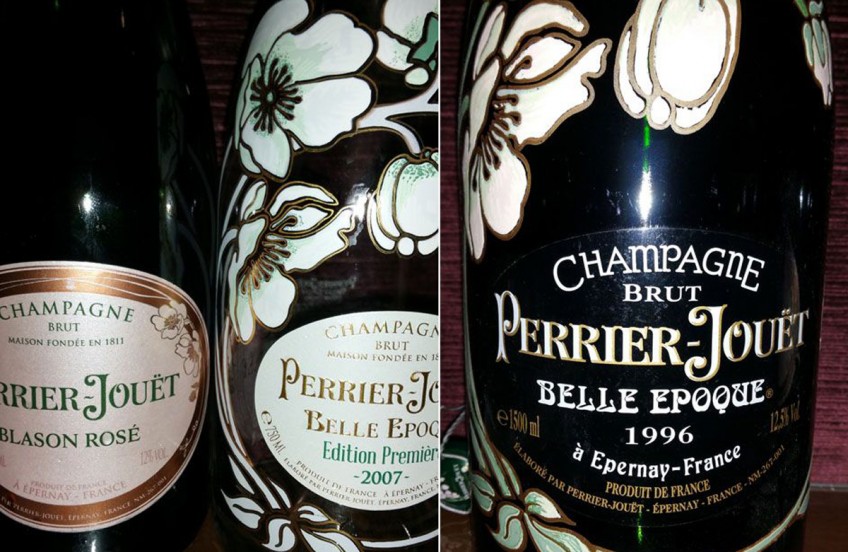Champagne for dinner, anyone?

Mention champagne and celebrations immediately come to mind - weddings, birthdays, anniversaries. It's something you make a toast with, have as an aperitif at the start of the meal, and that would seem to be its main function.
But as the sole drink of choice throughout an entire meal, instead of conventional white and red wines? Not so much. Perhaps, at a Chinese wedding or birthday dinner, which is less circumscribed by the norms that accompany a Western meal.
Of course, it is possible, with one or two injunctions and special attention to a few details, to serve champagne throughout, say, a French dinner. Champagne is basically white wine which, during production, is bottled and corked and undergoes a secondary fermentation in the bottle. Bubbles of carbon dioxide are formed in the wine as a result of this secondary fermentation, creating a "fizz".
A most ingenious trick. The character and integrity of the wine is not changed in any way except it is now full of bubbles, like aerated water!
The story behind this most interesting facet of winemaking is that around 1700AD a monk named Dom Perignon, while making wine for his colleagues, failed to notice that fermentation in the wine he was bottling had not yet been completed before the bottles were corked and sealed.
In the following spring as the weather warmed up, the pressure in the gas bubbles began to rise, resulting in some of the bottles exploding. Curious to find out what was going on, he uncorked a bottle that had not yet exploded, took a sip and made the startling discovery that it was fizzy! And thus, champagne was discovered and the name of the monk has been immortalised by Champagne Moet & Chandon, which named its most expensive cuvee "Dom Perignon".
Last week I had the privilege (and pleasure) of being a guest at a very special dinner hosted by my gracious hostess Nicola Lee, commandeur of the Singapore branch of Les Orde des Coteaux de Champagne, the official fraternity of the major Champagne houses.
The dinner, held at Les Amis Restaurant in Shaw House, presented a tasting of the champagnes of the famous champagne house of Perrier-Jouett. We had the additional pleasure of the presence of M Herve Deschamps, winemaker of Perrier-Jouett, himself to present the wines to us.
Wines
Champagne Perrier-Jouett Grand Brut NV;
Champagne Perrier-Jouett Blanson Rose;
Champagne Perrier-Jouett Belle Epoque Edition Premiere 2007;
Champagne Perrier-Jouett Belle Epoque 2007:
Champagne Perrier-Jouett Belle Epoque 1996 en magnum;
Champagne Perrier-Jouett Rose 2006
Tasting notes
P-J Blanson Rose NV
Very pale pink, delicate, light, sweet, fresh, fruity aroma. Lightly fizzy on palate, light, fruity flavours, good length, not much bubbles.
P-J Grand Brut NV
Light yellow, very light aroma similar to the preceding Rose, very light, fine, persistent bubbles. Quite sweet fruit on the palate with gentle fizz, more spritz than fizz. Good length, clean finish.
P-J Belle Epoque Edition Premiere 2007
Cepage: Chardonnay 50 per cent, Pinot Noir 45 per cent, Pinot Meunier 5 per cent
Very pale yellow, fine, gentle bubbles, no surface "bead" around perimeter of surface. Light, lemony flavour, good and persistent fine bubbles, clean, long finish.
P-J Belle Epoque 2007
Very pale yellow, with fine beaded rim of fine bubbles. Very attractive light aroma of citrus. Good depth of flavour, very good ripeness, very good long finish.
"2007 is a very special vintage, with early flowering, and producing big wines," says M Herve Deschamps.
P-J Belle Epoque 1996 en magnum
The best wine of the tasting, the best ripeness of fruit, great length and great freshness. Very aristocratic, very youthful, and very impressive. Exquisite.
P-J Belle Epoque Rose 2006
Very pale pink, light fruity scent like all the preceding wines. Good ripe fruit with good acidity and freshness, very fine and delicate. A lovely wine.
Impressions
Perrier-Jouett is not about intensity, density or power. It is about fine, delicate textures and above all, gentleness. You could apply the description of femininity to it. Where Dom Perignon is firm and dense, Belle Epoque is fine, almost filigree. It is by no means weak or insipid.
The fruit ripeness is there. It is just not in-your-face, as it were. It is there quietly in the background if you take the time to look for it.
It reminds me very much of Oliver Goldsmith's play She Stoops to Conquer. It is very different from the likes of Moet & Chandon's wines, in particular the Dom Perignon, Veuve Clicquot's wines, such as La Grande Dame, wines which are clearly bigger in size, intensity and power.
The champagnes that are somewhat similar are Pol Roger's Blanc de Blancs, Salon's Blanc de Blancs, albeit denser.
One observation intrigues me. The most impressive wine in the series was the Belle Epoque 1996. This wine epitomised the chief characteristics of P-J's style.
Could it be that that it will need the maturity of age to allow the great strengths of Belle Epoque to finally display its full potential?
Basic question: Did the champagnes accompany the dinner well? It most certainly did. The menu was well chosen, featuring asparagus, lobster, sea bass and pork loin. White wines would normally have been selected for the seafood and even the pork. White wine with fizz, that is, champagne, would have been an exercise in one-upsmanship.
Of course, there could be some who would opt for a red with the pork, but when you are served a deluxe cuvee of a top champagne house, would you quibble? I know I would not!

This article was first published on June 19, 2015.
Get The Business Times for more stories.